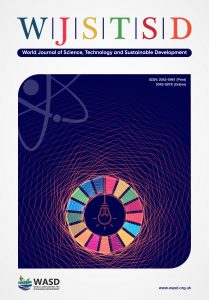Paleoecological studies of an archeological site in Sudan (Musawarat ElSufra): Evidence of climatic change, Dr. Amel Abdallah and Dr. Dafaala Ibrahim
Dr. Amel Hassan Abdallah , Dr. Dafaala Ali Ibrahim
, Dr. Dafaala Ali Ibrahim
Department of Botany, Faculty of Science
Khartoum University, Khartoum
Sudan
Email: amel762003@yahoo.com
DOI: 10.1108/WJSTSD-10-2015-0048
Purpose: The purpose of this paper is to measure the environmental changes, which took place in the study area Musawarat ElSufra and the authors try to find the causes of these changes and establish a comparison of the present and past vegetation of the area.
Design/methodology/approach: Present vegetation was investigated using fresh plant materials for pollen analysis. Fossils were taken from the hafir (basin) to study the fossil pollen grains at different soil depths. Soil surface samples were taken to analyze the chemical and physical properties of the soil.
Findings: The pollen analysis of the samples taken from the hafir (basin) of Musawarat reveals that there are 21 species belonging to 16 families. The dominant families were Cyperaceae, Commelinaceae, Mimosaceae and Amaranthaceae.
Originality/value: Comparison of past and present vegetation reveal the causes of environmental change and insure sustainable development in arid region.
Keywords: Climate change; Paleoecology; Fossils pollen analysis.
Citation: Abdallah, A.H. and Ibrahim, D.A. (2015), "Paleoecological studies of an archeological site in Sudan (Musawarat ElSufra): Evidence of climatic change", World Journal of Science, Technology and Sustainable Development, Vol. 12 No. 4, pp. 246-256. https://doi.org/10.1108/WJSTSD-10-2015-0048

